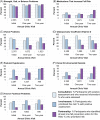Engagement of older adults in STRIDE's multifactorial fall injury prevention intervention
- PMID: 35924574
- PMCID: PMC9669158
- DOI: 10.1111/jgs.17983
Engagement of older adults in STRIDE's multifactorial fall injury prevention intervention
Abstract
Background: Evidence-based multifactorial fall prevention interventions in clinical practice have been less effective than expected. One plausible reason is that older adults' engagement in fall prevention care is suboptimal.
Methods: This was a post-hoc analysis of 2403 older adults' engagement in a multifactorial fall prevention intervention in the Strategies to Reduce Injuries and Develop Confidence in Elders (STRIDE) pragmatic trial. Based on the direct clinical care level of the Patient and Family Continuum of Engagement (CE) framework, three indicators of progressively interactive engagement were assessed: (1) Consultation (receiving information), (2) Involvement (prioritizing risks), and (3) Partnership (identifying prevention actions). Drop off at each step was determined as well as predictors of engagement.
Results: The participants' engagement waned with increasingly interactive CE domains. Although all participants received information about their positive fall risk factors (consultation) and most (51%-96%) prioritized them (involvement), fewer participants (33%-55%) identified fall prevention actions (partnership) for most of their risk factors, except for strength gait or balance problems (95%). More participants (70%) identified home exercises than other actions. Finally, fall prevention actions were identified more commonly among participants who received two visits compared to one (OR = 2.33 [95% CI, 2.06-2.64]), were ≥80 years old (OR = 1.83 [95% CI, 1.51-2.23]), and had fewer fall risk factors (OR = 0.90 [95% CI, 0.83-0.99]).
Conclusions: The drop-off in participants' engagement based on the level of their interaction with clinicians suggests that future multifactorial fall prevention interventions need to be more focused on interactive patient-clinician partnerships that help older adults increase and maintain fall prevention actions. Our analyses suggest that more frequent contact with clinicians and more monitoring of the implementation and outcomes of Fall Prevention Care Plans could potentially improve engagement and help older adults maintain fall prevention actions.
Keywords: Fall Prevention; Older Adults; Patient Engagement; Primary Care.
© 2022 The Authors. Journal of the American Geriatrics Society published by Wiley Periodicals LLC on behalf of The American Geriatrics Society.
Conflict of interest statement
The authors declare that there is no conflict of interest.
Figures


Similar articles
-
Prevention of falls and fall-related injuries in community-dwelling seniors: an evidence-based analysis.Ont Health Technol Assess Ser. 2008;8(2):1-78. Epub 2008 Oct 1. Ont Health Technol Assess Ser. 2008. PMID: 23074507 Free PMC article.
-
Fall prevention interventions in primary care to reduce fractures and falls in people aged 70 years and over: the PreFIT three-arm cluster RCT.Health Technol Assess. 2021 May;25(34):1-114. doi: 10.3310/hta25340. Health Technol Assess. 2021. PMID: 34075875 Free PMC article. Clinical Trial.
-
Exercise for preventing falls in older people living in the community.Cochrane Database Syst Rev. 2019 Jan 31;1(1):CD012424. doi: 10.1002/14651858.CD012424.pub2. Cochrane Database Syst Rev. 2019. PMID: 30703272 Free PMC article.
-
Determining Whether a Dosage-Specific and Individualized Home Exercise Program With Consults Reduces Fall Risk and Falls in Community-Dwelling Older Adults With Difficulty Walking: A Randomized Control Trial.J Geriatr Phys Ther. 2018 Jul/Sep;41(3):161-172. doi: 10.1519/JPT.0000000000000114. J Geriatr Phys Ther. 2018. PMID: 27893567 Clinical Trial.
-
Effectiveness of multifactorial interventions in preventing falls among older adults in the community: A systematic review and meta-analysis.Int J Nurs Stud. 2020 Jun;106:103564. doi: 10.1016/j.ijnurstu.2020.103564. Epub 2020 Mar 7. Int J Nurs Stud. 2020. PMID: 32272282
Cited by
-
Reframing Fall Prevention and Risk Management as a Chronic Condition Through the Lens of the Expanded Chronic Care Model: Will Integrating Clinical Care and Public Health Improve Outcomes?Gerontologist. 2024 Jun 1;64(6):gnae035. doi: 10.1093/geront/gnae035. Gerontologist. 2024. PMID: 38666718 Free PMC article.
-
Reducing Falls Among Community-Dwelling Older Adults From Clinicians' Perspectives: A Systems Modeling Approach.Innov Aging. 2023 Jul 20;7(7):igad077. doi: 10.1093/geroni/igad077. eCollection 2023. Innov Aging. 2023. PMID: 37694132 Free PMC article.
-
Motivational Interviewing for Fall Prevention (MI-FP) pilot study: Older Adults' readiness to participate in fall prevention.Geriatr Nurs. 2023 Nov-Dec;54:246-251. doi: 10.1016/j.gerinurse.2023.09.017. Epub 2023 Oct 15. Geriatr Nurs. 2023. PMID: 37847939 Free PMC article.
-
Considerations When Designing and Implementing Pragmatic Clinical Trials That Include Older Hispanics.Ethn Dis. 2024 Apr 10;33(2-3):76-83. doi: 10.18865/ed.33.2-3.076. eCollection 2023 Apr. Ethn Dis. 2024. PMID: 38845738 Free PMC article.
-
A co-designed conceptual model for implementing falls prevention programmes for community-dwelling older adults in Singapore: a systems thinking approach.Age Ageing. 2025 Feb 2;54(2):afaf021. doi: 10.1093/ageing/afaf021. Age Ageing. 2025. PMID: 39976285 Free PMC article.

